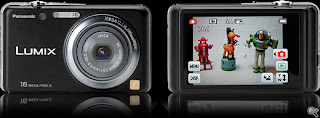The Panasonic Lumix DMC-FH7 is a slim, stylish
compact camera with a 16MP CCD sensor and a 4x optically-stabilized zoom
lens, which covers a useful 28-112mm (equivalent) range. Similar in
most respects to its predecessor the FH5, the FH7 features a new
touch-sensitive LCD screen, which enables Touch AF - a feature which has
trickled down from higher-end Lumix cameras which allows you to focus
and release the shutter by simply touching the display.
With the FH7, Panasonic is squarely targeting the consumer-level point-and-shoot market, and as such, apart from its stylish, minimalist design, the camera is packed with beginner-friendly and 'lifestyle' features. Beauty retouch, Aesthetic and Makeup filters are all designed to quickly polish portrait photographs, and a built-in Image Uploader is intended to make it easy to upload captured files to Facebook or YouTube when either the camera, or memory card, are connected to an Internet-enabled computer. Speaking of connectivity, the FH7 does not feature an HDMI connection, only USB 2.0 for connection to a computer or television (AV out).
With the FH7, Panasonic is squarely targeting the consumer-level point-and-shoot market, and as such, apart from its stylish, minimalist design, the camera is packed with beginner-friendly and 'lifestyle' features. Beauty retouch, Aesthetic and Makeup filters are all designed to quickly polish portrait photographs, and a built-in Image Uploader is intended to make it easy to upload captured files to Facebook or YouTube when either the camera, or memory card, are connected to an Internet-enabled computer. Speaking of connectivity, the FH7 does not feature an HDMI connection, only USB 2.0 for connection to a computer or television (AV out).
Specification at-a-glance
- 16.2 effective Megapixels
- 28-112mm equiv lens with optical stabilization
- 3in touch-sensitive LCD screen with 230k dot resolution
- 720p (30fps) video mode
- ISO sensitivity up to 1600
- Built-in Image Uploader (requires PC with Internet connection)
- Street price $179 (£110)
Design / Key Features
The FH7's slim metal body is free from the plethora of buttons that we'd expect to see on higher-end Lumix models. In fact, there are only two buttons (power on/off and the shutter release) on the top plate, and none on the rear. The only thing on the rear of the FH7 is its 3in touch-screen, and this is the camera's main control point. Virtually every aspect of the camera's operation is (or can be) controlled via the screen, using touch. Even the shutter release can be reassigned to touch operation if desired.The FH7's built-in Image Uploader makes uploading still and video files to Facebook and YouTube relatively stress-free, although you'll need to be using a Windows PC (sorry Mac users), and you will still need to follow fairly detailed instructions found in the camera's PDF user manual to do it. Quite honestly, if you're a reasonably adept computer-user we'd recommend just transferring files to your PC in the usual way, via USB or a card reader, and uploading to the web using your normal workflow.





Tidak ada komentar:
Posting Komentar